Sociological Analysis of Aboriginal Australian Issues and Challenges
VerifiedAdded on 2022/12/28
|8
|2094
|43
Essay
AI Summary
This essay delves into the sociological issues faced by Aboriginal Australians, examining the historical context of concentration camps, the lack of representation in policy making, and the ongoing socioeconomic disparities. It analyzes these issues through various sociological frameworks, including Marxist and feminist perspectives, and draws upon the autobiography of Ruth Hegarty to illustrate the lived experiences of Aboriginal people. The essay highlights the impact of colonization, marginalization, and unequal power dynamics, emphasizing the need for improved representation, social justice, and the elimination of trust deficits to facilitate the rehabilitation and mainstreaming of Aboriginal communities. The analysis underscores the importance of addressing these issues to promote the overall development and productivity of Australia.
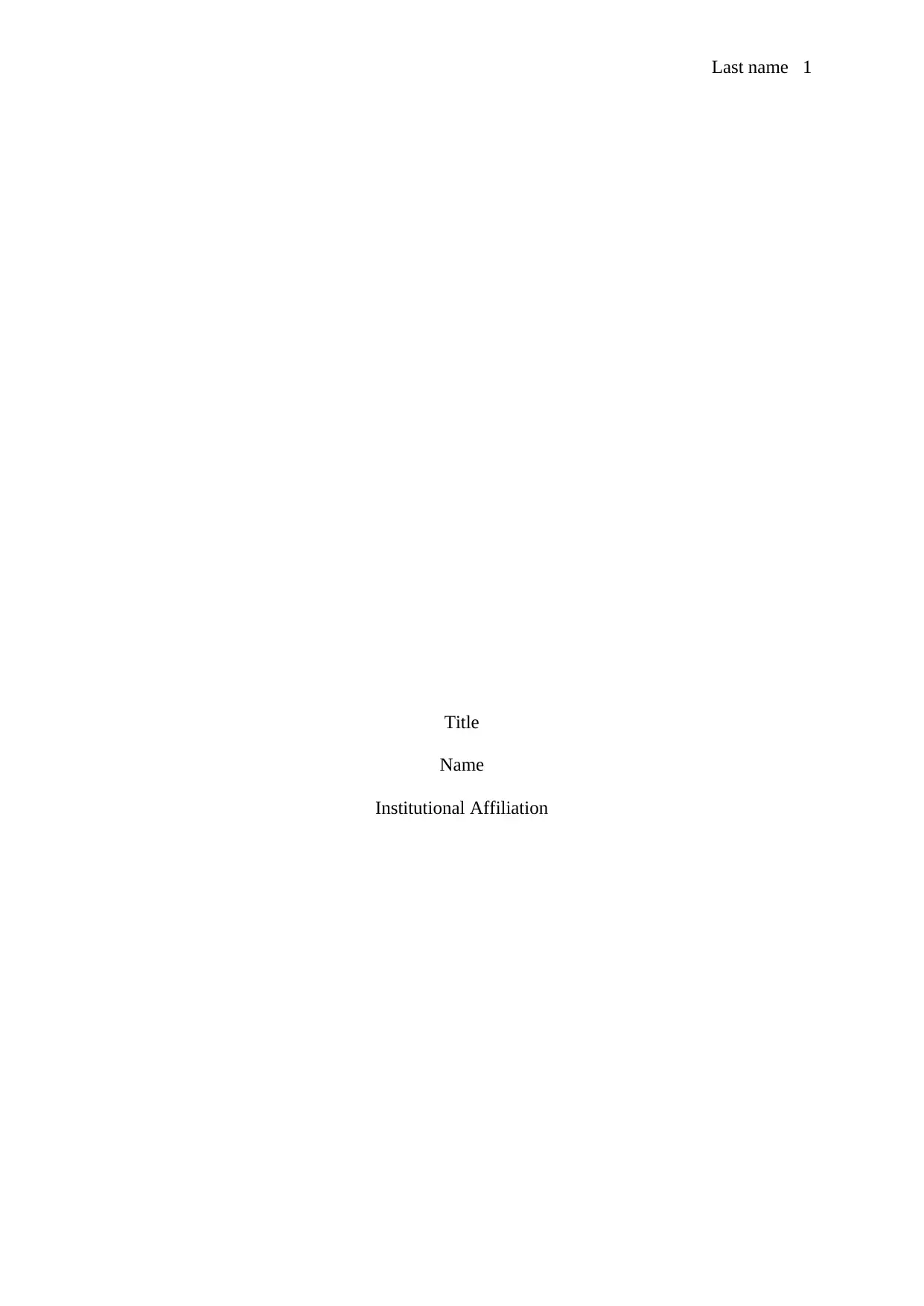
Last name 1
Title
Name
Institutional Affiliation
Title
Name
Institutional Affiliation
Paraphrase This Document
Need a fresh take? Get an instant paraphrase of this document with our AI Paraphraser
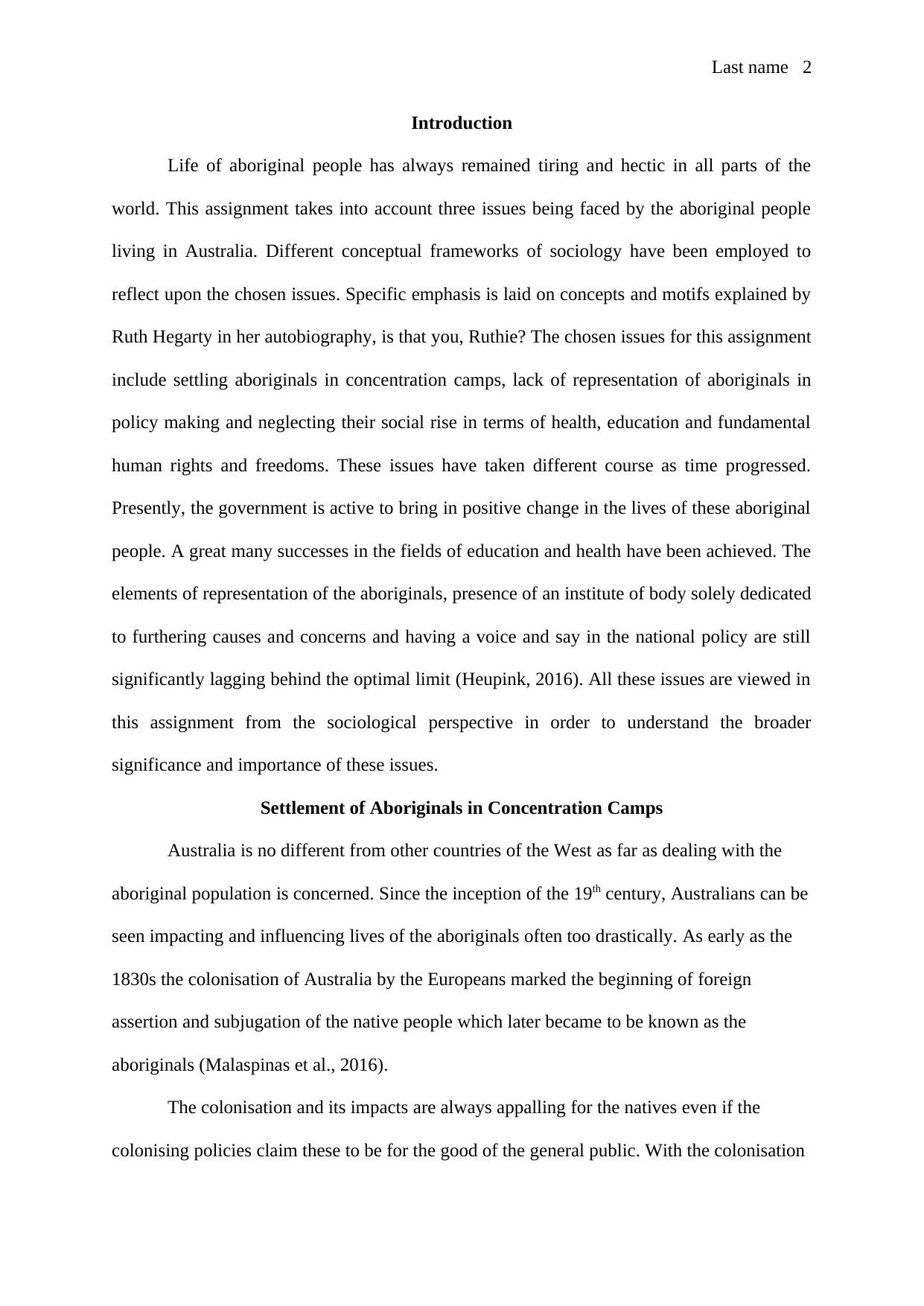
Last name 2
Introduction
Life of aboriginal people has always remained tiring and hectic in all parts of the
world. This assignment takes into account three issues being faced by the aboriginal people
living in Australia. Different conceptual frameworks of sociology have been employed to
reflect upon the chosen issues. Specific emphasis is laid on concepts and motifs explained by
Ruth Hegarty in her autobiography, is that you, Ruthie? The chosen issues for this assignment
include settling aboriginals in concentration camps, lack of representation of aboriginals in
policy making and neglecting their social rise in terms of health, education and fundamental
human rights and freedoms. These issues have taken different course as time progressed.
Presently, the government is active to bring in positive change in the lives of these aboriginal
people. A great many successes in the fields of education and health have been achieved. The
elements of representation of the aboriginals, presence of an institute of body solely dedicated
to furthering causes and concerns and having a voice and say in the national policy are still
significantly lagging behind the optimal limit (Heupink, 2016). All these issues are viewed in
this assignment from the sociological perspective in order to understand the broader
significance and importance of these issues.
Settlement of Aboriginals in Concentration Camps
Australia is no different from other countries of the West as far as dealing with the
aboriginal population is concerned. Since the inception of the 19th century, Australians can be
seen impacting and influencing lives of the aboriginals often too drastically. As early as the
1830s the colonisation of Australia by the Europeans marked the beginning of foreign
assertion and subjugation of the native people which later became to be known as the
aboriginals (Malaspinas et al., 2016).
The colonisation and its impacts are always appalling for the natives even if the
colonising policies claim these to be for the good of the general public. With the colonisation
Introduction
Life of aboriginal people has always remained tiring and hectic in all parts of the
world. This assignment takes into account three issues being faced by the aboriginal people
living in Australia. Different conceptual frameworks of sociology have been employed to
reflect upon the chosen issues. Specific emphasis is laid on concepts and motifs explained by
Ruth Hegarty in her autobiography, is that you, Ruthie? The chosen issues for this assignment
include settling aboriginals in concentration camps, lack of representation of aboriginals in
policy making and neglecting their social rise in terms of health, education and fundamental
human rights and freedoms. These issues have taken different course as time progressed.
Presently, the government is active to bring in positive change in the lives of these aboriginal
people. A great many successes in the fields of education and health have been achieved. The
elements of representation of the aboriginals, presence of an institute of body solely dedicated
to furthering causes and concerns and having a voice and say in the national policy are still
significantly lagging behind the optimal limit (Heupink, 2016). All these issues are viewed in
this assignment from the sociological perspective in order to understand the broader
significance and importance of these issues.
Settlement of Aboriginals in Concentration Camps
Australia is no different from other countries of the West as far as dealing with the
aboriginal population is concerned. Since the inception of the 19th century, Australians can be
seen impacting and influencing lives of the aboriginals often too drastically. As early as the
1830s the colonisation of Australia by the Europeans marked the beginning of foreign
assertion and subjugation of the native people which later became to be known as the
aboriginals (Malaspinas et al., 2016).
The colonisation and its impacts are always appalling for the natives even if the
colonising policies claim these to be for the good of the general public. With the colonisation
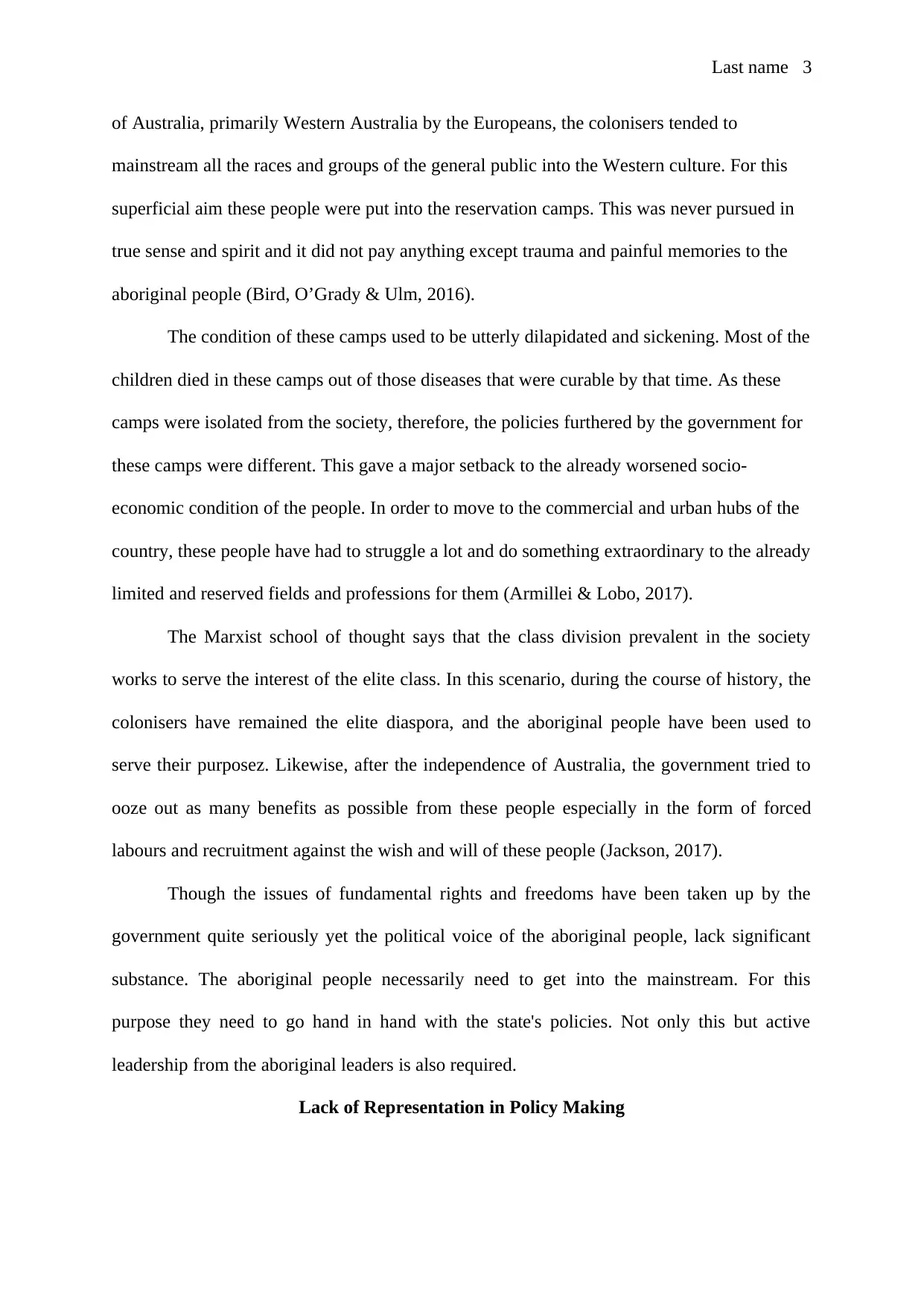
Last name 3
of Australia, primarily Western Australia by the Europeans, the colonisers tended to
mainstream all the races and groups of the general public into the Western culture. For this
superficial aim these people were put into the reservation camps. This was never pursued in
true sense and spirit and it did not pay anything except trauma and painful memories to the
aboriginal people (Bird, O’Grady & Ulm, 2016).
The condition of these camps used to be utterly dilapidated and sickening. Most of the
children died in these camps out of those diseases that were curable by that time. As these
camps were isolated from the society, therefore, the policies furthered by the government for
these camps were different. This gave a major setback to the already worsened socio-
economic condition of the people. In order to move to the commercial and urban hubs of the
country, these people have had to struggle a lot and do something extraordinary to the already
limited and reserved fields and professions for them (Armillei & Lobo, 2017).
The Marxist school of thought says that the class division prevalent in the society
works to serve the interest of the elite class. In this scenario, during the course of history, the
colonisers have remained the elite diaspora, and the aboriginal people have been used to
serve their purposez. Likewise, after the independence of Australia, the government tried to
ooze out as many benefits as possible from these people especially in the form of forced
labours and recruitment against the wish and will of these people (Jackson, 2017).
Though the issues of fundamental rights and freedoms have been taken up by the
government quite seriously yet the political voice of the aboriginal people, lack significant
substance. The aboriginal people necessarily need to get into the mainstream. For this
purpose they need to go hand in hand with the state's policies. Not only this but active
leadership from the aboriginal leaders is also required.
Lack of Representation in Policy Making
of Australia, primarily Western Australia by the Europeans, the colonisers tended to
mainstream all the races and groups of the general public into the Western culture. For this
superficial aim these people were put into the reservation camps. This was never pursued in
true sense and spirit and it did not pay anything except trauma and painful memories to the
aboriginal people (Bird, O’Grady & Ulm, 2016).
The condition of these camps used to be utterly dilapidated and sickening. Most of the
children died in these camps out of those diseases that were curable by that time. As these
camps were isolated from the society, therefore, the policies furthered by the government for
these camps were different. This gave a major setback to the already worsened socio-
economic condition of the people. In order to move to the commercial and urban hubs of the
country, these people have had to struggle a lot and do something extraordinary to the already
limited and reserved fields and professions for them (Armillei & Lobo, 2017).
The Marxist school of thought says that the class division prevalent in the society
works to serve the interest of the elite class. In this scenario, during the course of history, the
colonisers have remained the elite diaspora, and the aboriginal people have been used to
serve their purposez. Likewise, after the independence of Australia, the government tried to
ooze out as many benefits as possible from these people especially in the form of forced
labours and recruitment against the wish and will of these people (Jackson, 2017).
Though the issues of fundamental rights and freedoms have been taken up by the
government quite seriously yet the political voice of the aboriginal people, lack significant
substance. The aboriginal people necessarily need to get into the mainstream. For this
purpose they need to go hand in hand with the state's policies. Not only this but active
leadership from the aboriginal leaders is also required.
Lack of Representation in Policy Making
⊘ This is a preview!⊘
Do you want full access?
Subscribe today to unlock all pages.

Trusted by 1+ million students worldwide

Last name 4
The issue detailed above is more historic than being recent or prevalent one. For any
race, clan, creed or overall nation to adapt to the changing and challenging dynamics of life
representation of that entity in the policy-making is utterly essential. In the past as well as in
the present the representation of the aboriginal people in policy making has remained
compromised. They have never been represented either by their true representatives or by the
equitable number of representatives. This lack of representation gave a major setback to the
political evolution and growth of the aboriginal people as they never felt a stake in the
policies. This is the central reason which has served to keep aboriginal disinterested in any of
the policy carved by the government for their betterment (Wilson & Wilks, 2015).
At times, the aboriginals got one or the other leader who spoke their heart out but
having a single leader or guide without helpers who could not run the campaign nationwide
for lump-sum of 3 per cent of the entire population certainly is a sheer injustice. This is how
the voice of the aboriginal people always remained smouldering and could not reach the
houses of policymaking. The failure of different initiatives taken by the government, for
example, Closing the Gap policy can be connected with this fact quite perfectly that these
people were never given a stake in the policies and programs which were made for them
(Patrick & Moodie, 2016).
An important concept of sociology is the prevalence of unequal relationships within a
society. These unequal relationships exist in every society and lead to the prevalence of large
scale discrepancies in society. The weaker ones or those who are kept marginalised do not
enjoy any say in the social affairs. This marginalisation had led the aboriginal people to stay
dependent on different interest groups and compromise their wellbeing in all fields and
professions. The elite class of all the societies be it western, eastern, European or Asian, is
always capable of taking the bigger chunk of the cake and nothing reaches down the lowest
class even by dint of the trickledown effect. A systematic approach is made to keep one class
The issue detailed above is more historic than being recent or prevalent one. For any
race, clan, creed or overall nation to adapt to the changing and challenging dynamics of life
representation of that entity in the policy-making is utterly essential. In the past as well as in
the present the representation of the aboriginal people in policy making has remained
compromised. They have never been represented either by their true representatives or by the
equitable number of representatives. This lack of representation gave a major setback to the
political evolution and growth of the aboriginal people as they never felt a stake in the
policies. This is the central reason which has served to keep aboriginal disinterested in any of
the policy carved by the government for their betterment (Wilson & Wilks, 2015).
At times, the aboriginals got one or the other leader who spoke their heart out but
having a single leader or guide without helpers who could not run the campaign nationwide
for lump-sum of 3 per cent of the entire population certainly is a sheer injustice. This is how
the voice of the aboriginal people always remained smouldering and could not reach the
houses of policymaking. The failure of different initiatives taken by the government, for
example, Closing the Gap policy can be connected with this fact quite perfectly that these
people were never given a stake in the policies and programs which were made for them
(Patrick & Moodie, 2016).
An important concept of sociology is the prevalence of unequal relationships within a
society. These unequal relationships exist in every society and lead to the prevalence of large
scale discrepancies in society. The weaker ones or those who are kept marginalised do not
enjoy any say in the social affairs. This marginalisation had led the aboriginal people to stay
dependent on different interest groups and compromise their wellbeing in all fields and
professions. The elite class of all the societies be it western, eastern, European or Asian, is
always capable of taking the bigger chunk of the cake and nothing reaches down the lowest
class even by dint of the trickledown effect. A systematic approach is made to keep one class
Paraphrase This Document
Need a fresh take? Get an instant paraphrase of this document with our AI Paraphraser
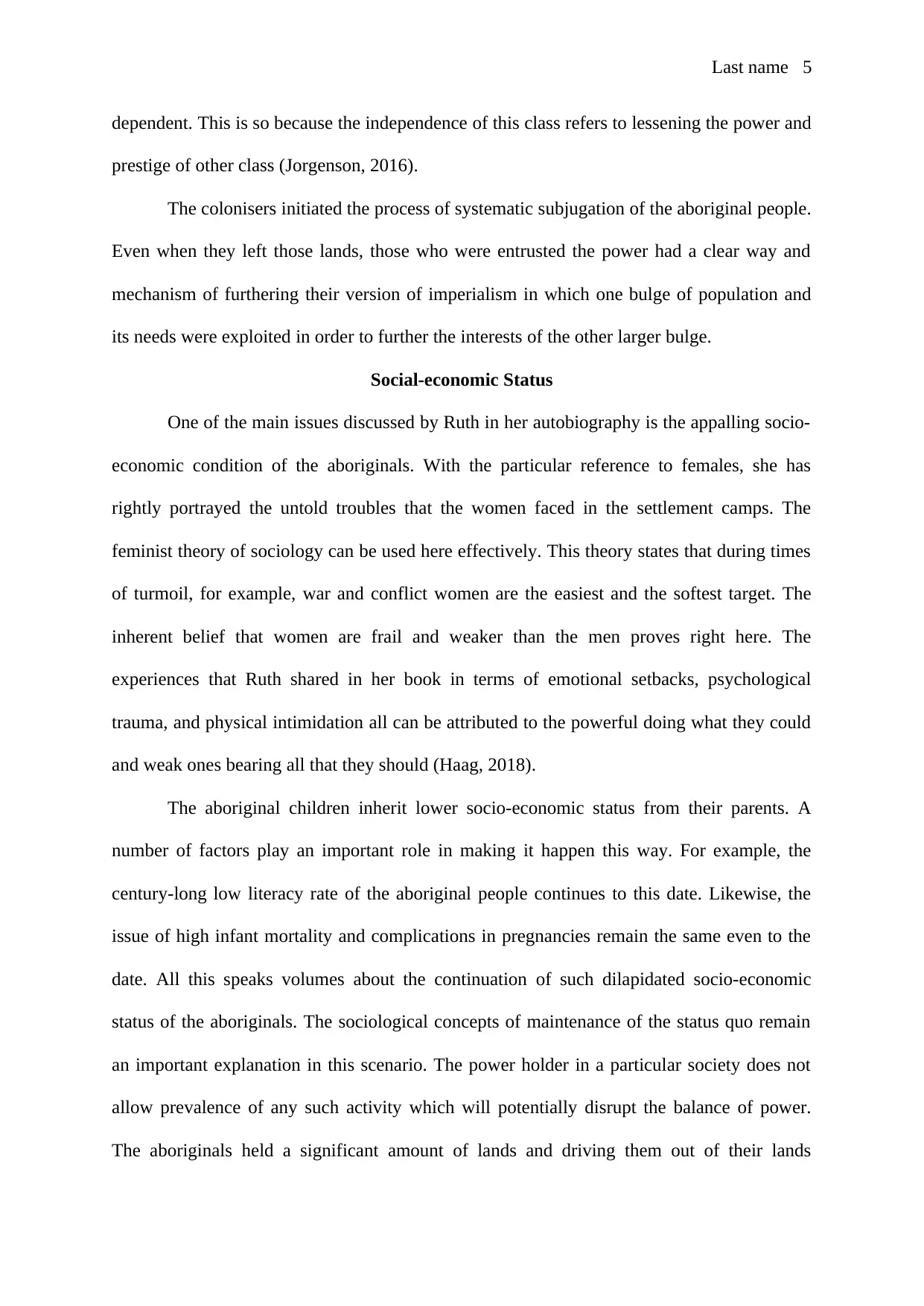
Last name 5
dependent. This is so because the independence of this class refers to lessening the power and
prestige of other class (Jorgenson, 2016).
The colonisers initiated the process of systematic subjugation of the aboriginal people.
Even when they left those lands, those who were entrusted the power had a clear way and
mechanism of furthering their version of imperialism in which one bulge of population and
its needs were exploited in order to further the interests of the other larger bulge.
Social-economic Status
One of the main issues discussed by Ruth in her autobiography is the appalling socio-
economic condition of the aboriginals. With the particular reference to females, she has
rightly portrayed the untold troubles that the women faced in the settlement camps. The
feminist theory of sociology can be used here effectively. This theory states that during times
of turmoil, for example, war and conflict women are the easiest and the softest target. The
inherent belief that women are frail and weaker than the men proves right here. The
experiences that Ruth shared in her book in terms of emotional setbacks, psychological
trauma, and physical intimidation all can be attributed to the powerful doing what they could
and weak ones bearing all that they should (Haag, 2018).
The aboriginal children inherit lower socio-economic status from their parents. A
number of factors play an important role in making it happen this way. For example, the
century-long low literacy rate of the aboriginal people continues to this date. Likewise, the
issue of high infant mortality and complications in pregnancies remain the same even to the
date. All this speaks volumes about the continuation of such dilapidated socio-economic
status of the aboriginals. The sociological concepts of maintenance of the status quo remain
an important explanation in this scenario. The power holder in a particular society does not
allow prevalence of any such activity which will potentially disrupt the balance of power.
The aboriginals held a significant amount of lands and driving them out of their lands
dependent. This is so because the independence of this class refers to lessening the power and
prestige of other class (Jorgenson, 2016).
The colonisers initiated the process of systematic subjugation of the aboriginal people.
Even when they left those lands, those who were entrusted the power had a clear way and
mechanism of furthering their version of imperialism in which one bulge of population and
its needs were exploited in order to further the interests of the other larger bulge.
Social-economic Status
One of the main issues discussed by Ruth in her autobiography is the appalling socio-
economic condition of the aboriginals. With the particular reference to females, she has
rightly portrayed the untold troubles that the women faced in the settlement camps. The
feminist theory of sociology can be used here effectively. This theory states that during times
of turmoil, for example, war and conflict women are the easiest and the softest target. The
inherent belief that women are frail and weaker than the men proves right here. The
experiences that Ruth shared in her book in terms of emotional setbacks, psychological
trauma, and physical intimidation all can be attributed to the powerful doing what they could
and weak ones bearing all that they should (Haag, 2018).
The aboriginal children inherit lower socio-economic status from their parents. A
number of factors play an important role in making it happen this way. For example, the
century-long low literacy rate of the aboriginal people continues to this date. Likewise, the
issue of high infant mortality and complications in pregnancies remain the same even to the
date. All this speaks volumes about the continuation of such dilapidated socio-economic
status of the aboriginals. The sociological concepts of maintenance of the status quo remain
an important explanation in this scenario. The power holder in a particular society does not
allow prevalence of any such activity which will potentially disrupt the balance of power.
The aboriginals held a significant amount of lands and driving them out of their lands
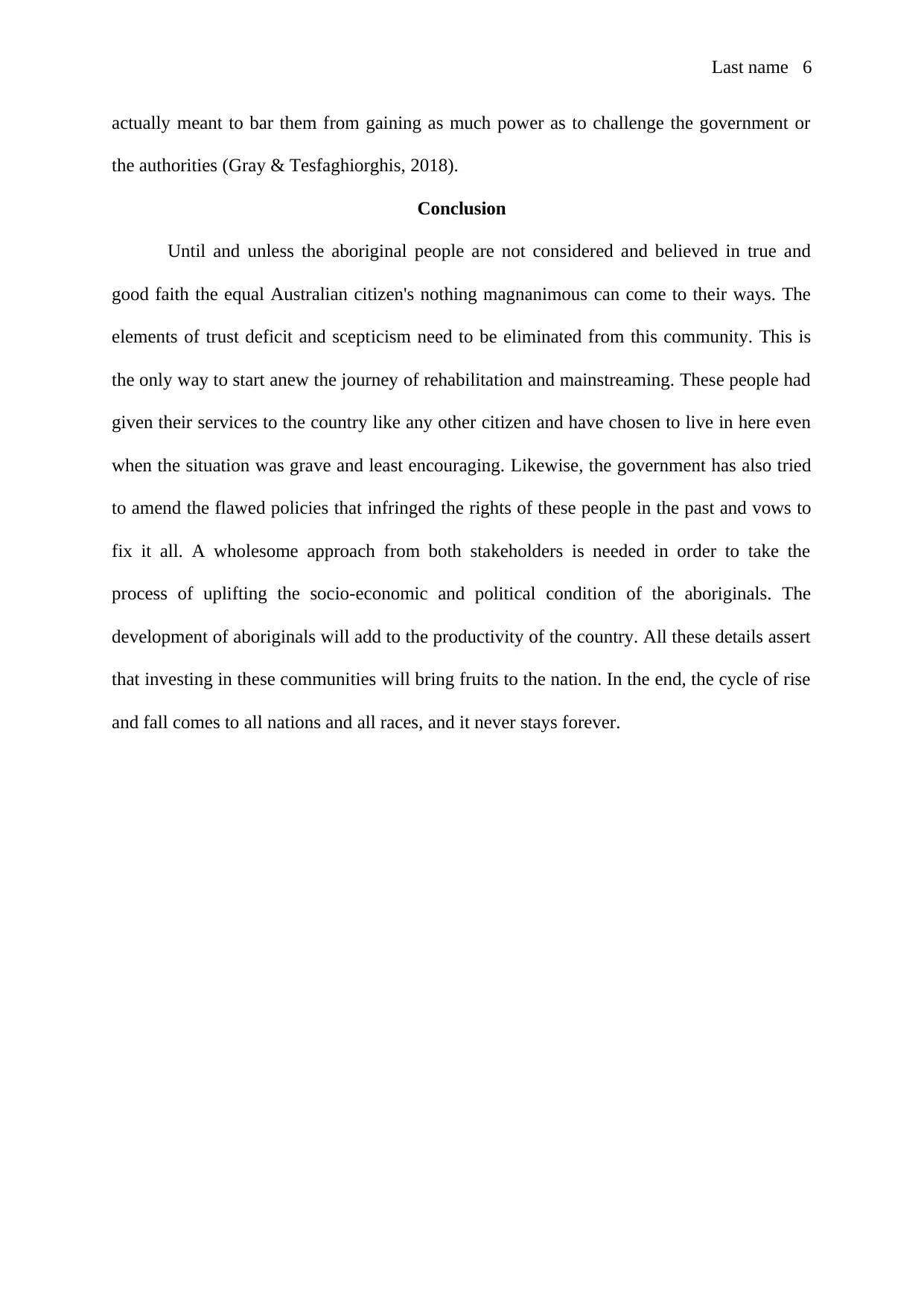
Last name 6
actually meant to bar them from gaining as much power as to challenge the government or
the authorities (Gray & Tesfaghiorghis, 2018).
Conclusion
Until and unless the aboriginal people are not considered and believed in true and
good faith the equal Australian citizen's nothing magnanimous can come to their ways. The
elements of trust deficit and scepticism need to be eliminated from this community. This is
the only way to start anew the journey of rehabilitation and mainstreaming. These people had
given their services to the country like any other citizen and have chosen to live in here even
when the situation was grave and least encouraging. Likewise, the government has also tried
to amend the flawed policies that infringed the rights of these people in the past and vows to
fix it all. A wholesome approach from both stakeholders is needed in order to take the
process of uplifting the socio-economic and political condition of the aboriginals. The
development of aboriginals will add to the productivity of the country. All these details assert
that investing in these communities will bring fruits to the nation. In the end, the cycle of rise
and fall comes to all nations and all races, and it never stays forever.
actually meant to bar them from gaining as much power as to challenge the government or
the authorities (Gray & Tesfaghiorghis, 2018).
Conclusion
Until and unless the aboriginal people are not considered and believed in true and
good faith the equal Australian citizen's nothing magnanimous can come to their ways. The
elements of trust deficit and scepticism need to be eliminated from this community. This is
the only way to start anew the journey of rehabilitation and mainstreaming. These people had
given their services to the country like any other citizen and have chosen to live in here even
when the situation was grave and least encouraging. Likewise, the government has also tried
to amend the flawed policies that infringed the rights of these people in the past and vows to
fix it all. A wholesome approach from both stakeholders is needed in order to take the
process of uplifting the socio-economic and political condition of the aboriginals. The
development of aboriginals will add to the productivity of the country. All these details assert
that investing in these communities will bring fruits to the nation. In the end, the cycle of rise
and fall comes to all nations and all races, and it never stays forever.
⊘ This is a preview!⊘
Do you want full access?
Subscribe today to unlock all pages.

Trusted by 1+ million students worldwide
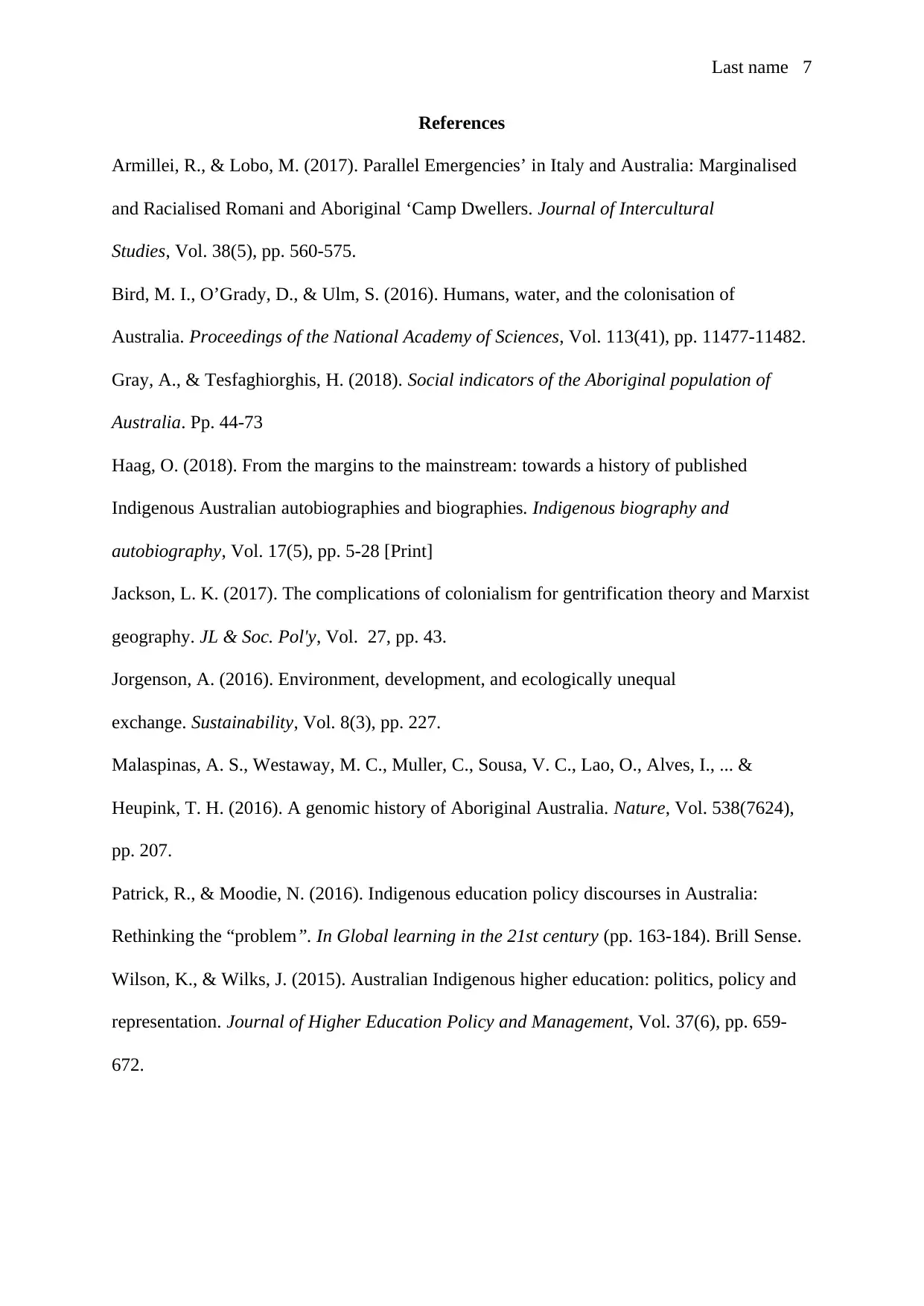
Last name 7
References
Armillei, R., & Lobo, M. (2017). Parallel Emergencies’ in Italy and Australia: Marginalised
and Racialised Romani and Aboriginal ‘Camp Dwellers. Journal of Intercultural
Studies, Vol. 38(5), pp. 560-575.
Bird, M. I., O’Grady, D., & Ulm, S. (2016). Humans, water, and the colonisation of
Australia. Proceedings of the National Academy of Sciences, Vol. 113(41), pp. 11477-11482.
Gray, A., & Tesfaghiorghis, H. (2018). Social indicators of the Aboriginal population of
Australia. Pp. 44-73
Haag, O. (2018). From the margins to the mainstream: towards a history of published
Indigenous Australian autobiographies and biographies. Indigenous biography and
autobiography, Vol. 17(5), pp. 5-28 [Print]
Jackson, L. K. (2017). The complications of colonialism for gentrification theory and Marxist
geography. JL & Soc. Pol'y, Vol. 27, pp. 43.
Jorgenson, A. (2016). Environment, development, and ecologically unequal
exchange. Sustainability, Vol. 8(3), pp. 227.
Malaspinas, A. S., Westaway, M. C., Muller, C., Sousa, V. C., Lao, O., Alves, I., ... &
Heupink, T. H. (2016). A genomic history of Aboriginal Australia. Nature, Vol. 538(7624),
pp. 207.
Patrick, R., & Moodie, N. (2016). Indigenous education policy discourses in Australia:
Rethinking the “problem”. In Global learning in the 21st century (pp. 163-184). Brill Sense.
Wilson, K., & Wilks, J. (2015). Australian Indigenous higher education: politics, policy and
representation. Journal of Higher Education Policy and Management, Vol. 37(6), pp. 659-
672.
References
Armillei, R., & Lobo, M. (2017). Parallel Emergencies’ in Italy and Australia: Marginalised
and Racialised Romani and Aboriginal ‘Camp Dwellers. Journal of Intercultural
Studies, Vol. 38(5), pp. 560-575.
Bird, M. I., O’Grady, D., & Ulm, S. (2016). Humans, water, and the colonisation of
Australia. Proceedings of the National Academy of Sciences, Vol. 113(41), pp. 11477-11482.
Gray, A., & Tesfaghiorghis, H. (2018). Social indicators of the Aboriginal population of
Australia. Pp. 44-73
Haag, O. (2018). From the margins to the mainstream: towards a history of published
Indigenous Australian autobiographies and biographies. Indigenous biography and
autobiography, Vol. 17(5), pp. 5-28 [Print]
Jackson, L. K. (2017). The complications of colonialism for gentrification theory and Marxist
geography. JL & Soc. Pol'y, Vol. 27, pp. 43.
Jorgenson, A. (2016). Environment, development, and ecologically unequal
exchange. Sustainability, Vol. 8(3), pp. 227.
Malaspinas, A. S., Westaway, M. C., Muller, C., Sousa, V. C., Lao, O., Alves, I., ... &
Heupink, T. H. (2016). A genomic history of Aboriginal Australia. Nature, Vol. 538(7624),
pp. 207.
Patrick, R., & Moodie, N. (2016). Indigenous education policy discourses in Australia:
Rethinking the “problem”. In Global learning in the 21st century (pp. 163-184). Brill Sense.
Wilson, K., & Wilks, J. (2015). Australian Indigenous higher education: politics, policy and
representation. Journal of Higher Education Policy and Management, Vol. 37(6), pp. 659-
672.
Paraphrase This Document
Need a fresh take? Get an instant paraphrase of this document with our AI Paraphraser
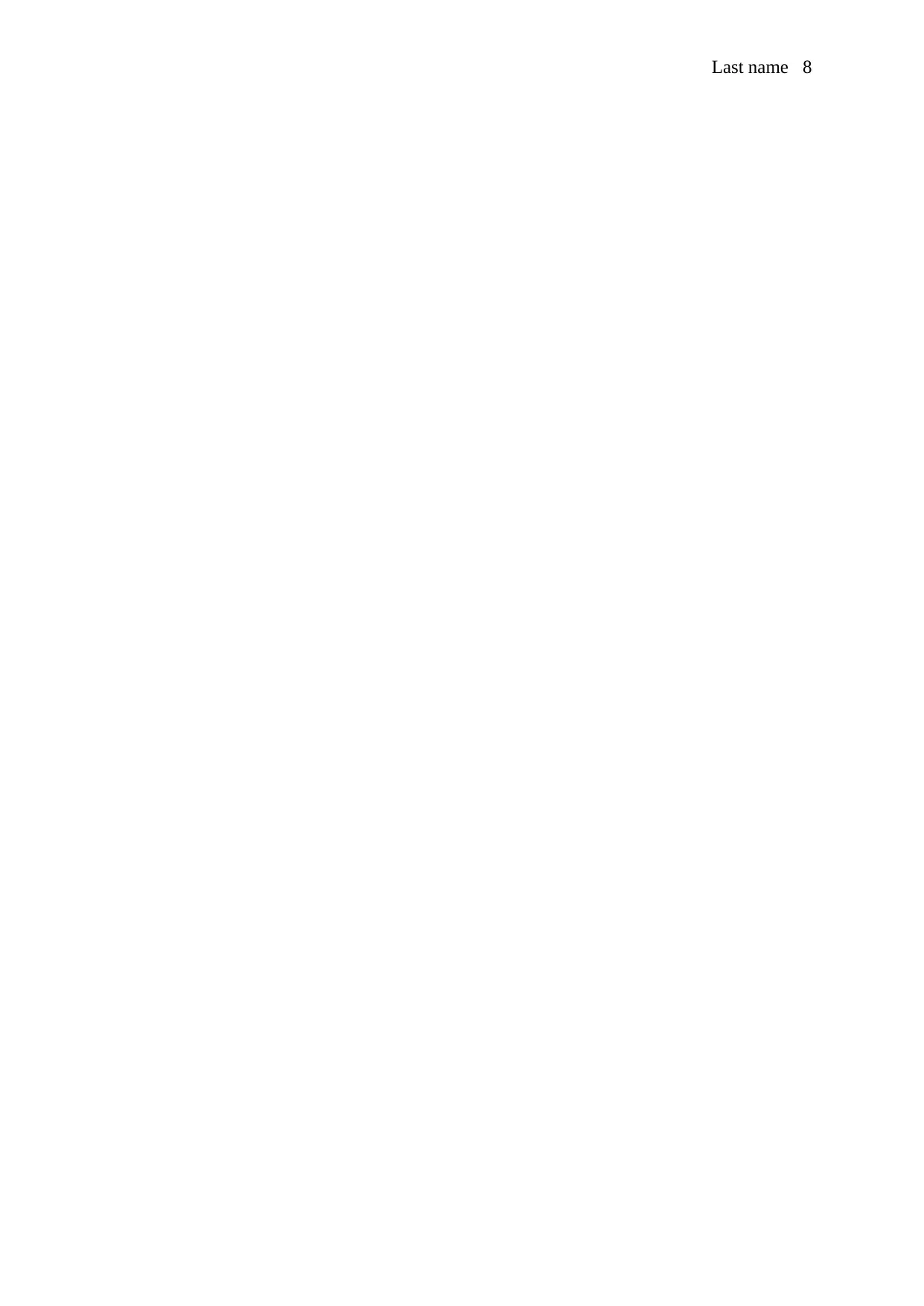
Last name 8
1 out of 8
Related Documents
Your All-in-One AI-Powered Toolkit for Academic Success.
+13062052269
info@desklib.com
Available 24*7 on WhatsApp / Email
![[object Object]](/_next/static/media/star-bottom.7253800d.svg)
Unlock your academic potential
Copyright © 2020–2025 A2Z Services. All Rights Reserved. Developed and managed by ZUCOL.





